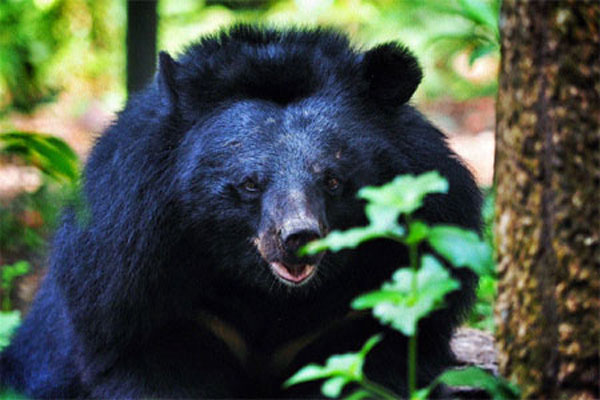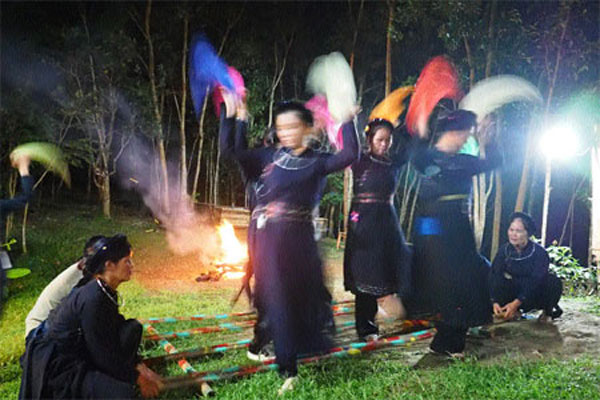
North of HCM City and 13km from Cat Tien National Park, Ta Lai Commune's ethnic minority population has used traditional skills and dances learned from ancestors to make a living in tourism.
North of HCM City and 13km from Cat Tien National Park, Ta Lai Commune's ethnic minority population has used traditional skills and dances learned from ancestors to make a living in tourism.
 |
|
Croc country: Bau Sau in the heart of Cat Tien National Park, which is home to more than 300 crocodiles living with the support of WWF Denmark. |
Tourism is slowly becoming one of the main work alternatives for ethnic people living close to nature. Some are now learning how to pass on their rural knowledge.
As nature retreats from the onrush of civilisation and the onslaught of power saws, the trees have retreated into ever decreasing pockets. Now tribal people can recycle their skills and attitudes to help them survive.
Situated 150km north of HCM City and 13km from Cat Tien National Park, Ta Lai Commune in Dong Nai Province is home to 8,000 people, of whom 30 per cent are from the Chau Ma, S'Tieng and Tay communities living on the edge of the park.
A community-based tourism model is now helping local people earn a new livelihood that confronts illegal logging and hunting.
 |
|
Fancy flat: A traditional E De ethnic group house in the park that serves tourists. |
Dieu Ne, a S'Tieng tribal man, lives at his wife's home in Ta Lai Commune in the southern Dong Nai Province. This is the custom in a community that is basically matriarchal.
Ne, 55, who comes from Binh Phuoc Province, married a Chau Ma woman in 1985 and stayed at his wife's house following tradition of her people.
For 30 years, Nea has struggled against poverty. He has collected medicinal herbs and other products from the forests and hunted small animals to survive.
Four years ago, he joined a community-based tourism project with support from World Wildlife Federation of Viet Nam. He began working at Ta Lai long-house, a traditional bamboo lodge for the Chau Ma group in Ta Lai Commune, which looks after visitors seeking wildlife adventure tours in the national park.
 |
|
Out of the zoo: Animals at the park's Wildlife Rescue Centre (from above, black bear, northern buffed-cheeked gibbon, leopard). |
"I'm acquainted with the life and culture of the Chau Ma. I have spoken their language for 30 years since I fell in love with my wife," Ne said. "I enjoy happiness with five children. Three have their own families. I also now live well as a tour guide."
The 55-year-old earns VND130,000 (US$6.20) a day at the long house - and farms at his leisure. Ne received a VND5 million ($238) loan from the Community Development Fund, which is funded by tourism services at the house.
 |
|
|
"I bought two goats, and started breeding. A goat can make VND3 million at market. I just spend time cutting grass for them," he said, adding that goat breeding was very productive.
"I no longer collect forest products. It is mostly illegal and I have been persuading the rest of the community that the dwindling forests need protection," he said. "It is not easy, but I believe the community will eventually change when it sees the advantages - and the close relationship between the old way of life and the new."
Nguyen Hong Tram Anh, marketing executive at Ta Lai Long House, said the company, Carphex shared benefits with the community.
"Thirty per cent of revenue goes to the Community Development Fund. We have donated nearly VND100 million ($4,760) to the fund to help livestock development," Anh said.
"The fund helps improve infrastructure and provide scholarships for students and helps support the old. The poorest people are the first borrowers," she said.
She said one by one they receive loans to breed livestock and invest in coffee and cashew farms.
"Tourism has also revived brocade weaving, gong and bamboo pole dancing by the Chau Ma, S'Tieng and Tay groups. They earn VND2.5 million ($119) for a 15-minute night performance for tourists," she said.
 |
|
Hands up in the air: Women in the Tay ethnic group dance to entertain tourists. |
She said local people also benefited from providing transport, brocade and working as tour guides.
Trieu Thi Tay, 56, an employee at the longhouse, said she was paid VND3.3 million ($157) a month for full-time work.
"It's quite good for me. I also receive life insurance benefits from the job as well as receiving loans to raise livestock," Tay said.
"We have been trained in cuisine, hospitality, reception and tourism skills with support from the WWF. It's much better than searching the forest for products," Tay said. She said goats and buffaloes were profitable as well as cashews, coffee and pepper.
Ka Huong, 25, a longhouse guide, said: "It's an easy job for me as I guide tourists trekking through the jungle of Cat Tien National Park or go kayaking in Vam Ho Lake."
She said she planed to gather children together to learn gong playing and traditional dances from old people to preserve the folk culture.
"Only the elderly play gongs, but they are over 70. Young people still find it boring and most of them cannot play."
|
WWF strides In 2008, World Wide Fund for Nature (WWF) Denmark and WWF Viet Nam jointly implemented the project Ecotourism in and around National Parks in Viet Nam. The commune-based tourism service, which was initiated by World Wild Fund for Nature (WWF) in 2010 and put into operation in 2012, has created a stable income for the first eight workers and 91 part-time workers as well as eight households providing transport. The project has also helped ease illegal hunting and logging in Cat Tien National Park, a UNESCO-recognised biosphere reserve. |
According to a report from WWF Viet Nam, tourism services here have provided VND958 million ($47,000) revenue for part-time labourers and travel providers in the last two years.
Vice chairwoman of the Ta Lai Commune's People's Committee, Pham Thi Vinh, said the community-based tourism helped improve living standards and forest protection.
"Local people understand that tourism is the new trade," she said. "We have not seen illegal hunting in recent years, but some local people harvest bamboo shoots during the rainy season between August and October," she said.
"The commune has carried out forest protection since 2012. More than 100 villagers receive a VND1 million a quarter for forest patrol work and protection along with rangers," she said. "The local people look out for illegal logging and hunting in the park. They also dismantle any traps they find."
Brocade weaving has revived since the creation of community-based tourism at the longhouse.
Ka Dieu, 49, said it was a good job as people could live on the skills handed down by their ancestors. However, only a dozen or so people can still weave.
Matthew Wood, manager of the longhouse, said local people were being taught how to cook European cuisine, while adding their traditional food to the menu. The longhouse can host 32 visitors and more than 100 tents.
(Source:VNS)





